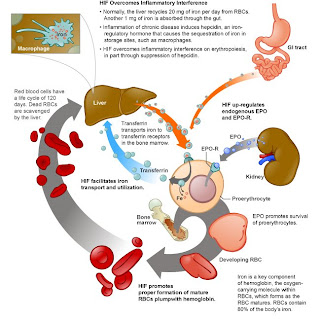double click to enlarge
 The most common type of anemia is iron-deficiency anemia, which occurs when the body's need for iron increases, as during certain periods of childhood and in pregnancy, or when there is insufficient iron in the diet. Pernicious anemia, a chronic ailment that mostly affects people over 40, is a result of vitamin B12 deficiency, often caused by decreased B12 absorption rather than a deficient diet. The most common symptoms of anemia are pallor, shortness of breath, low vitality, dizziness, and digestive disorders. Sickle-cell anemia is the result of a hereditary defect in the synthesis of hemoglobin.
The most common type of anemia is iron-deficiency anemia, which occurs when the body's need for iron increases, as during certain periods of childhood and in pregnancy, or when there is insufficient iron in the diet. Pernicious anemia, a chronic ailment that mostly affects people over 40, is a result of vitamin B12 deficiency, often caused by decreased B12 absorption rather than a deficient diet. The most common symptoms of anemia are pallor, shortness of breath, low vitality, dizziness, and digestive disorders. Sickle-cell anemia is the result of a hereditary defect in the synthesis of hemoglobin.Past treatment of the disease has included removal of the spleen, repeated transfusions of blood, and a diet featuring beef or calf's liver. Transfusions are still used in cases of acute blood loss; iron supplements for iron-deficiency anemia and injections of vitamin B12 for pernicious anemia are often effective. Synthetically manufactured erythropoietin (normally produced by the human kidney) is now used to stimulate the production and growth of red blood cells. Other therapy focuses on curing the underlying causes of the nutritional or hormonal deficiency.
See also BLOOD: BLOOD DISEASES. Anemia